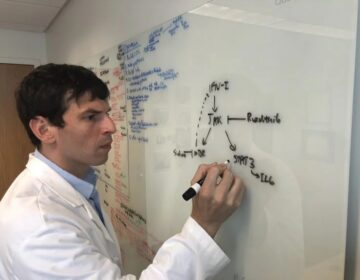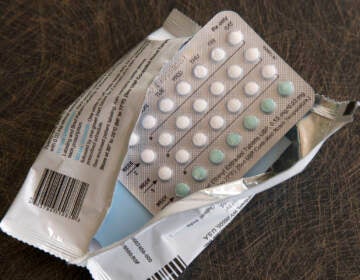The hidden players putting independent pharmacies out of business
How pharmacy benefit managers impacted one independent pharmacist.
Listen 15:22
How pharmacy benefit managers impacted one independent pharmacist. (Fand Std. / Big Stock Photo)
This story is from The Pulse, a weekly health and science podcast.
Subscribe on Apple Podcasts, Spotify or wherever you get your podcasts.
Editor’s note: Many independent pharmacies say their business model is threatened by pharmacy benefit managers. To see the impact on one business, reporter Liz Tung interviewed a pharmacist over the course of many months to better understand the issues facing him. In the end, he said he wanted to share what happened to him, but only under the condition of anonymity — he was afraid of backlash from PBMs. We have verified and fact-checked his story, and decided to tell it without using his real name. We’re calling him Bill.
The story of how Bill opened his own pharmacy is about as small-town wholesome as it gets. He first got interested while working at one in high school. And from the beginning, it just felt like a good fit.
“I felt like I wanted to go into health care, and wanted to be able to help patients,” he said. “But I didn’t want to go through a medical school or be a nurse, and I thought that pharmacy would be a good choice for me. The chemistry interested me, and of course the patient interaction was always a good thing as well.”
So Bill went to pharmacy school, and spent the next decade or so working for someone else. Finally, around 15 years ago, he worked up the nerve to open his own business.
“It’s something I’ve always wanted to do — I just never had the gumption,” Bill said. “It’s probably the best decision I made.”
It seemed like a good move. Shortly after opening his own pharmacy, the shop he’d worked at previously shut down, and Bill inherited many of his old customers. “The money wasn’t great, but it was decent.”
Like a lot of community pharmacies, Bill’s business offered personal service — they knew their patients by name, would call them on their birthdays, and even deliver prescriptions right to their doors.
Trouble begins — enter PBMs
It’s hard to pinpoint when exactly things started going south. Bill estimates it was around 2013 when business earnings began to fall.
“There was a drastic decline,” Bill said. After a slight recovery, the pharmacy’s income continued into steady decline.
Bill said the majority of the pharmacy’s earnings come from reimbursements — the money it gets for dispensing prescriptions.
Reimbursements are a lot of pharmacies’ bread and butter, which has become a problem in recent years because pharmacy benefit managers, or PBMs, play a major role in how they work.
PBMs arose in the late 1960s to help insurance companies process prescription claims. Before that, patients had to mail their own prescription claims to their insurance companies and wait to get reimbursed.
With PBMs, the process was streamlined and digitized, easing the burden on insurance companies, and becoming an important link between pharmacies and health plans.
Over the coming years, PBMs’ responsibilities expanded to include reimbursements — the money health plans pay pharmacies to reimburse them for the cost of the medications they dispense. Insurance companies empowered PBMs not only to pay pharmacies, but to decide how much money they should receive.
The problem, pharmacies say, is that over the years, reimbursements have been shrinking, to the point that some aren’t even receiving enough to cover the original cost of the drugs they buy.
What PBMs bring to the table
Pharmacy benefit managers can do this for a few reasons. For one thing, there’s a huge amount of secrecy that surrounds how they operate. The details of the contracts they write, of the formulas they use to calculate reimbursements, are often insanely complicated — or hidden, or both. And that leads to situations such as pharmacies actually losing money on prescriptions they dispense.
Another reason PBMs can get away with lowering reimbursements is that pharmacies need them. Three PBMs control around 75% of the market, so if pharmacies want access to all those customers, they have to accept the PBMs’ terms.
PBMs, however, say they’re justified by their role in the health care world — lowing costs.
“There’s sometimes a lack of understanding as to just how much value and savings PBMs provide in our health care system,” said Greg Lopes, spokesman for the Pharmaceutical Care Management Association, the PBMs’ trade association.
“Over the next 10 years, PBMs are going to save health plan sponsors and consumers more than $1 trillion on prescription drug costs. PBMs are hired by employers, unions, and government programs to negotiate with drug manufacturers on their behalf because of their expertise in lowering drug costs. There’s no requirement to hire a PBM, but health care plan sponsors and employers choose to work with PBMs because we lower drug costs and increase quality of care.”
Pharmacists dispute that characterization, among them Mel Brodsky, executive director of the Philadelphia Association of Retail Druggists, a group that represents about 200 stores in Southeastern Pennsylvania.
“The only thing that I’ve seen them be able to do is increase health care costs [and] put independent pharmacies out of business,” Brodsky said. “And [they] have become so powerful now that they don’t listen to politicians or regulations or laws that they don’t like. And they find ways to take them to court and put injunctions on laws and on regulations that they don’t like. They have become so powerful, it’s just ridiculous.”
Falling reimbursements and growing fees
Bill noticed the decrease in reimbursements starting around 2013. But it wasn’t until fall of 2019 that they fell off a cliff.
“They started deducting about $4,500 a week from my current checks that I was getting,” Bill said.
Bill’s weekly reimbursement checks usually ranged from $5,000 to $15,000, which meant the deductions were eating up anywhere from 30% to 90% of his income.
So Bill checked with his pharmacy services administrative organization — basically, a middleman group that represents independent pharmacies’ interests in contract negotiations with PBMs. Bill found out that the deductions were because of a debt — a debt no one had bothered to tell him about, totaling $79,000.
“I was extremely, extremely shocked,” Bill said.
This nightmare scenario is something that’s been happening to more and more pharmacies over the past few years. It’s part of a widely reviled practice called “clawbacks” — fees, often totally unpredictable, that PBMs charge pharmacies to “claw back” some of the money they’ve already paid them in reimbursements.
Subscribe to The Pulse
For instance, imagine if you started a job under the agreement that you’d get paid $4,000 a month. But after six months, you get a notification that your account is overdrawn. When you check your account history, you see that a couple months ago, your job decreased your salary from $4,000 a month to $3,000 a month without telling you. When you confront your boss, he tells you, “Yeah, we decided that $4,000 was just too much. So we changed your salary to $3,000 a month … And by the way, that’s retroactive, which means you owe us $6,000 — $1,000 for every month we ‘overpaid’ you. So we’ll just deduct that from your current paychecks.”
Sound unfair? That’s what a lot of pharmacists think too. How can PBMs be allowed to take back payments they’ve already made, for services already rendered?
In part, it relates, ironically enough, to what was supposed to be an incentive program. The Centers for Medicare and Medicaid came up with quality measures to make sure pharmacists were taking good care of their Medicare patients.
“Adherence to your drugs, making sure that if you’re diabetic, you’re checking your sugar levels — all these things that their Medicare would like you to do,” said health care consultant Susan Lang, who’s spent years working with pharmacies and PBMs. “If you do those things, then we will pay you extra because you’re a high-performing pharmacy.”
In other words, pharmacies were supposed to get financial rewards for good performance.
But instead, experts and pharmacists said, PBMs have largely used these standards against pharmacies, punishing them financially for “underperforming” without ever fully explaining how they’re making those judgments.
“That’s not really pay-for-performance,” Lang said. “That’s just price-gouging.”
For the pharmacists, it’s like playing a high-stakes game without knowing the rules — or worse, a game in which there are no rules.
“They have no line of sight on the calculations of how the PBM calculated what they get back,” Lang said. “So it’s completely nontransparent. They’re at the mercy of the PBM. And they have to just trust that the PBM is doing the right thing for them. Which, why would you?”
What the PBMs have to say
PBMs, however, say the rules of their incentive programs are totally transparent — even those related to the most reviled clawbacks of all, called direct and indirect remuneration fees, or DIR for short.
“Pharmacy DIR is a performance-based system with rewards and penalties,” said Lopes, from the Pharmaceutical Care Management Association, which represents the 11 largest PBMs in the country. “And the penalties, yes, are paid at retroactively, but they are transparent. They are well known to the independent pharmacy. That information is available to them in real time.”
So does that mean that if independent pharmacists just looked closely at their contracts, then they’d be able to predict how much they need to pay in clawbacks?
“That is correct,” Lopes said. “We think if independent — all pharmacies, I should say, retail and independent — looked at their contracts closely and worked with their PSAO, they would understand where these incentives lie and where they are at with meeting them.”
The pharmacy services administrative organizations, the PSAOs, — the groups that represent independent pharmacies at the table with PBMs — and their own lack of transparency are the real problem, Lopes said.
Bill, however, doesn’t agree. While he admits that PSAOs are partially responsible, he puts the majority of the blame on PBMs.
Bill also disputes Lopes’ characterization of DIR fees as an “incentive program.”
“Even if you’re perfect, you did everything you possibly could, you are 100%,” Bill said, “they still take money back.”
Susan Lang said that these clawback fees, combined with shrinking reimbursements, are putting more and more pharmacies in an untenable position.
“I talked to a pharmacist a few months ago who went out of business, and he told me initially his DIR fees were running about $20,000 a month, say four years ago,” Lang said. “And then they were running $50,000 a month and then $60,000 a month. And finally, they were not sustainable, and, he said, `I had to close shop.’”
The long road to closing
That was Bill’s fear when he was first interviewed last spring. He’d just received back-to-back clawback fees totaling nearly $200,000, and had been struggling to make ends meet.
“Obviously, I’ve cut my salary,” Bill said. “I’ve had to cut staff, And that doesn’t feel great either, on a personal level.”
Five months later, Bill said things had gone from bad to worse. Business was down because of the pandemic, and he’d taken out a loan to stay afloat.
He was stressed and exhausted, frustrated and angry.
“Tremendous amount of stress,” Bill said. “Sleep sometimes is an issue. I think it’s more of your mind racing, and you’re trying to go to sleep, but you’ll get up and then start thinking again, and then can’t go back to sleep.”
Bill couldn’t stop thinking about the worst-case scenario — losing his business. What would he do if that happened?
“Pray that I could find a job,” Bill said with a little laugh, citing his family with three kids. “I just turned 50, so I still have at least 15 to 20 years to work. So I would definitely have to figure out something.”
But it wasn’t just the financial pressures stressing Bill out — it was the fact that he felt so helpless.
“You’re sitting there, and you’re powerless. No one wants to help you,” Bill said. “Your wholesaler can’t give you a better price on your cost of goods. The PSAO who you thought was helping you are signing bad contracts on your behalf. And the PBM, you know, they don’t care. They’re just making money hand over fist. So here we are all by ourselves on this little island.”
Bill finally decided to sell his pharmacy in the fall
“It was one of the toughest decisions I had to make,” he said. “I went back and forth multiple, multiple times — multiple discussions with my wife, with my business partners. And we could not see a light at the end of the tunnel.”
It was the end of an era for Bill, who said some of his customers he’s been helping for nearly 30 years.
“I watched kids grow up, I’ve watched grandchildren be born,” Bill said. “So yeah, the patients and my staff is what I’m going to miss the most.”
For now, Bill is dusting off his resume, trying to make contacts, and figuring out what he’s going to do next. As for whether he’ll ever own a pharmacy again?
“The only possible way I think I would ever do that again at this point is if I knew for sure that PBMs were gone no longer in the equation,” Bill said. “Or had some serious oversight and nowhere near the power that they have over independent pharmacy.”
WHYY is your source for fact-based, in-depth journalism and information. As a nonprofit organization, we rely on financial support from readers like you. Please give today.







